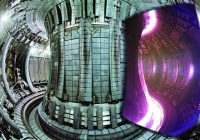
The research, which has received £1.7m of funding from the EPSRC, will be crucial to the government’s plans to build new nuclear power stations across Britain over the next 30 years.
Prof Mike Fitzpatrick, who is leading the project at the Open University, said that existing production of materials for future reactors lacked detailed research, which would be needed if the UK is to develop and maintain its engineering skills in the nuclear industry.
’There has been a lot of work on possible materials for new reactors, but in many cases the production of these materials has been small scale and there hasn’t been a great deal of understanding about exactly what benefits they might bring,’ he added.
The lack of information is largely due to the difficulty of testing materials once they have been subject to the nuclear environment, causing them to become radioactive.
’Working on radioactive materials is challenging,’ said Prof Steve Roberts from Oxford University’s Department of Materials. ’If you’re dealing with nuclear materials and how they behave after neutron irradiation, the standard technique is to “cook” them in a nuclear reactor for months or years. After you take them out they’re too radioactive to test in a normal laboratory.’
Roberts’ team, which is also working on a wider £6m-funded project in this area, will be taking an alternative approach to testing by using sub-millimetre-sized samples of non-radioactive material.
The technique involves using focused ion beam (FIB) milling to extract samples from materials irradiated using ion implantation methods that mimic the damage produced by high-energy neutrons.
Within a reactor, these neutrons are able to give rise to atomic scale changes in the internal microstructure of a material, primarily through displacing atoms and generating helium and hydrogen atoms through chemical transmutation reactions.
Fitzpatrick said: ’If we can combine the fundamentals of what is going on in ion implantation and the fundamentals of what goes on in reactor neutron implantation, then we should be able to look at the effects of ion irradiation damage and extrapolate what would happen in a reactor with nuclear radiation.’
Imperial University will also be using implantation techniques and will be combining its results with computer simulations to gain a more accurate understanding of the differences in durability between materials.
’That’s an opportunity we didn’t have in the 1970s,’ said Dr David Dye, who is leading the research at Imperial. ’Now we can do very large-scale atomic computer simulations. We could understand how irradiation damage progresses and how things such as hydrogen and heat interact with the displacement cascade using computer simulations that have maybe up to a few million atoms. And that’s enough to get the right sort of ideas about what is going on.’
Over the next four years, the universities of Loughborough, Manchester and Bristol will be collecting and sharing their results with Oxford, Imperial and the Open University on suitable materials that could be used to build safer and efficient nuclear plant.
Fitzpatrick is aware that the timescales to do this are very tight. ’This research has now become urgent,’ he said. ’We probably have around 10 years to build an understanding of materials in this area. We need to make sure that they are going to be available in that time and that the material skills are in place to make these reactors a reality.’
It is hoped that Generation Four fission reactors will be coming on-line in the UK by around 2030, and DEMO fusion reactors by 2030-35. The material specifications for these reactors are expected to be outlined by 2020.




Red Bull makes hydrogen fuel cell play with AVL
Formula 1 is an anachronistic anomaly where its only cutting edge is in engine development. The rules prohibit any real innovation and there would be...